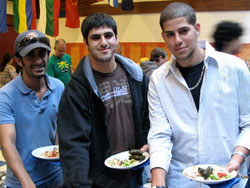In our ongoing effort to be green, reduce food waste, and to save water and energy, we have gone trayless! This is the next evolution in campus dining. After conducting several waste audits last year and measuring our waste, there is indisputable evidence that we can reduce uneaten food waste by as much as 18 tons per year. When factoring in the reduction of up to 3000 gallons of water a day per location and the energy to heat and run our dish machines, it makes a clear case for no debate on this change. This equates to over 300,000 gallons of water per year and is essential in preserving the water supply for future generations.
Going trayless has obvious waste reduction and energy saving benefits, but the waste reduction efforts don't stop there. Dining servers are encouraging students to try samples first so that entire portions don't go uneaten. Tasting cups are placed throughout the servery along with signs bearing the reminder to "Be a taster...not a waster." Sampling is a good way for students to make sure that a full serving is really what they want, especially with foods that may be new and different to them. Serving single portions, and encouraging return trips will also be a renewed practice with dining servers.
Dining currently serves over 10,000 meals per day, so saving even an ounce of uneaten food per plate really has a significant impact when you do the math. Until a full compost program is put into place, all of this is currently being sent to our local landfill, which is reaching capacity at an alarming rate.
An added benefit of removing the trays is that students can better control their own eating patterns that have resulted in loading their trays with unwanted food. Taking more than they can possible eat has created a culture of portion abuse. When less food is taken, the customer truly eats only what is wanted, which is healthier and UC Santa Cruz Dining gets a more accurate picture of how much to produce. Less food purchased/prepared and then dumped in the trash means the dollars are available to enhance other components of the dining experience.
Other universities that have gone trayless are reporting higher satisfaction with the quality of food, as students now go directly to their table with their food hot, instead of visiting more food stations to load up a tray while food on the first plate gets cold.
Frequently Asked Questions:
Where will all the old trays go?
Dining is reviewing several agencies that would welcome the donation. Some elementary schools, and other non-profit organizations might continue to use trays.
What about special needs and other ADA accommodations?
There will be a few trays available upon request. We are also happy to provide assistance in delivering food/beverage to your table.
I thought you were composting?
Yes, but our current pilot program involves only the cuttings from the kitchens, which are transported to the compost site in Watsonville. All post-consumer food waste is going into the trash cans. There are costs associated with composting. Creating less waste is the most efficient way of reduction!
Will this make a difference?
Yes, the potential to reduce the amount of food waste is very significant. The university, along with the Office of the President, is committed to reaching our Zero Waste goals and reducing our food waste is one of the largest contributions that we can make! We're helping to reduce our carbon footprint for future generations and hope that you'll join us and adapt to this change!

